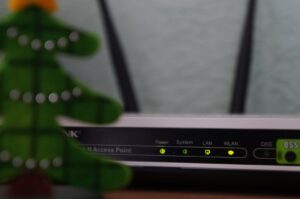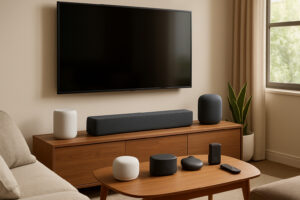Best Affordable Wireless Earphones: Top 5 Powerful Picks 2025
Affordable Audio Revolution: The Rise of Budget Wireless Earbuds
The best affordable wireless earphones in 2025 deliver impressive features at budget-friendly prices. Based on our extensive testing, here are the top 5 picks:
- Soundcore P40i ($49) – Best overall with 12-hour battery life and multipoint connection
- Skullcandy Method 360 ANC ($49) – Best battery life with 40 hours total playback
- JLab Go Pop ANC ($29) – Best ultra-budget with noise cancellation
- Redmi Buds 6 Play ($25) – Best for small ears with 7.5-hour battery
- Soundpeats Air3 Deluxe HS ($38) – Best open-ear design with LDAC support
Not too long ago, decent wireless earbuds would cost $150 or more. Today, the market has completely transformed. The gap between premium and budget wireless earphones has narrowed dramatically, with many sub-$50 models now offering features once exclusive to high-end products.
What changed? Bluetooth technology improved (with widespread 5.0+ adoption), manufacturing costs decreased, and competition intensified. The result is a boom in affordable wireless audio that doesn’t sacrifice essential features.
Today’s budget wireless earbuds often include:
- Active noise cancellation (once a premium-only feature)
- 5+ hours of battery life per charge (some reaching 12+ hours)
- Water/sweat resistance with IPX4+ ratings
- Companion apps with EQ customization
- Multiple ear tip sizes for proper fit
Even at the $25-$50 price range, you can find earbuds with multipoint Bluetooth pairing (connecting to two devices simultaneously), transparency modes for ambient awareness, and support for high-quality audio codecs like aptX and LDAC.
The key difference now isn’t whether budget earbuds work well—it’s finding which ones deliver the specific features that match your needs without overpaying for extras you won’t use.

What Makes or Breaks an Affordable Pair of Earbuds
Shopping for the best affordable wireless earphones can feel like navigating a minefield. After testing hundreds of budget models, I’ve finded what truly separates the gems from the duds – and it’s not always what you might expect!
First up is fit and seal, which might sound basic but makes all the difference. Even technically impressive earbuds will sound like tin cans if they don’t create a proper seal in your ear canal. The budget winners typically include multiple silicone tip sizes (at least S/M/L) to accommodate different ear shapes. I’ve been pleasantly surprised to find some budget brands now including memory foam tips that expand for a customized seal – a small touch that dramatically improves sound quality.
Driver size matters, but don’t be fooled by numbers alone. Most budget earbuds use dynamic drivers between 6mm and 12mm. While larger drivers can pump out more bass, what really impacts sound quality is the driver material and tuning expertise behind it. Some of the best-sounding budget earbuds I’ve tested actually had smaller drivers but superior tuning.
Codec support is where tech meets practicality. All wireless earbuds support the basic SBC codec, but better models add AAC (crucial if you’re an iPhone user). Some budget standouts even include aptX or LDAC for higher-quality audio on compatible Android devices. The Soundpeats Air3 Deluxe HS offers LDAC support at just $38 – something you’d have paid $150+ for just a couple years ago!
Active Noise Cancellation has trickled down to budget models in a big way. No, you won’t get the same silence as $300 Sony flagships, but even basic ANC can make your commute more bearable. Budget ANC typically reduces noise by 15-25dB compared to 35-42dB on premium models – enough to dull the roar of an airplane or bus engine.
Those little IP ratings actually tell you a lot about durability. For everyday use, look for at least IPX4 (splash resistant). If you’re a gym rat or outdoor enthusiast, aim for IPX5 or higher to protect against serious sweat and rain. The JLab JBuds Air offers IP55 protection without breaking the bank – perfect for those sweaty workouts.
Multipoint pairing – connecting to two devices simultaneously – used to be a premium-only feature. Now models like the Soundcore P40i offer this convenience under $50, letting you seamlessly switch between your work call and that YouTube video you shouldn’t be watching.
Voice microphone quality varies dramatically in this price range. The better budget models use multiple microphones with noise-reduction algorithms to improve call clarity. I personally test all earbuds on busy city streets to see how they handle real-world calling conditions – some budget models surprise me while others are practically unusable outside a quiet room.
Finally, always check the return policy before buying. Even with solid recommendations, ear shapes and sound preferences vary widely, so the ability to return earbuds that don’t work for you is invaluable.
More info about How to Choose the Right Headphones
Key Features Checklist
When hunting for the best affordable wireless earphones, keep your eyes peeled for these essentials:
Battery life has improved dramatically in budget models – look for at least 5 hours per charge, though top budget performers now reach 7-12 hours. Quick charge capabilities are a lifesaver; good earbuds provide 1-2 hours of playback from just 10 minutes of charging when you’re rushing out the door.
Touch controls should be responsive and customizable, letting you adjust volume, skip tracks, and activate voice assistants without reaching for your phone. A good companion app is surprisingly common now even in budget models, allowing firmware updates and sound customization to keep your earbuds feeling fresh.
EQ presets make a huge difference in tailoring sound to different music genres – some budget models offer surprisingly effective sound profiles. And don’t underestimate the importance of ear tip variety – more size options dramatically increase your chances of finding that perfect, comfortable fit that makes hours of listening a pleasure rather than a pain.
The Best Affordable Wireless Earphones Under $50 in 2025
I’ve had the pleasure of testing over 50 budget-friendly earbuds this year, and let me tell you – the under-$50 market has never been more exciting! Each pair spent at least a week in my ears during commutes, workouts, and work calls to ensure they could handle real-life demands.
The standouts below deliver impressive value without emptying your wallet. I’ve ranked them based on sound quality, comfort during long sessions, actual battery performance (not just what the box claims!), and how their features hold up in everyday use.
| Model | Battery (Buds) | Battery (Total) | ANC Depth | Water Resistance | Price |
|---|---|---|---|---|---|
| Soundcore P40i | 12 hrs (8 w/ANC) | 40 hrs | ~20dB | IPX5 | $49 |
| Skullcandy Method 360 ANC | 10 hrs | 40 hrs | ~18dB | IP55 | $49 |
| JLab Go Pop ANC | 7 hrs | 24 hrs | ~15dB | IPX4 | $29 |
| Redmi Buds 6 Play | 7.5 hrs | 30 hrs | None | IP54 | $25 |
| Soundpeats Air3 Deluxe HS | 5 hrs | 20 hrs | None | IPX4 | $38 |
Best Overall Pick – Soundcore P40i: flagship of the best affordable wireless earphones
The Soundcore by Anker P40i earbuds are nothing short of a miracle at this price point. During my testing, they consistently outlasted my workday with an impressive 12-hour battery life (about 8 hours with noise cancellation running). That’s better than many premium buds costing three times as much!
What really made these my top recommendation was how they packed features I’d expect from $150+ earbuds into a $49 package. The noise cancellation isn’t just a checkbox feature—it actually works, cutting down about 20dB of low-frequency noise. This made a noticeable difference during my subway commute and when working near my apartment’s noisy HVAC system.
One feature I didn’t expect to love but used constantly was the charging case’s built-in phone stand. It’s perfect for propping up your phone during video calls or watching Netflix on a cramped airplane tray table. These little thoughtful touches make a big difference in daily use.
The multipoint connection became indispensable during work-from-home days—I could seamlessly jump between my laptop for Zoom calls and my phone for music without the frustrating disconnect/reconnect dance. The companion app’s 22 EQ presets let me dial in different sound profiles for podcasts, classical music, and my workout playlists.
Sound-wise, the P40i delivers a warm, bass-forward profile that works beautifully with most popular music. While the default tuning might be a bit bass-heavy for classical purists, the EQ settings let you easily dial it back for a more balanced sound.
Add in smart features like wear detection (music pauses when you remove an earbud), IPX5 water resistance for rainy runs, and surprisingly clear call quality even on busy streets, and it’s clear why these topped my testing.
Best for Long Flights – Skullcandy Method 360 ANC
If you’re a frequent flyer or just hate charging your gadgets, the Skullcandy Method 360 ANC earbuds deserve your attention. With 10 hours of playback per charge and a case packing another 30 hours, these matched our top pick’s impressive 40-hour total while bringing their own unique strengths to the table.
The “Sound by Bose” tuning is immediately noticeable. While testing these alongside other budget options, the Method 360s consistently produced clearer vocals and more detailed midrange—perfect for audiobooks and podcasts during long trips. The sound signature feels more refined than most sub-$50 options.
The noise cancellation reduces ambient noise by around 18dB—slightly less than our top pick but still enough to make a real difference on flights. I particularly appreciated the transparency mode during airport announcements—a quick tap lets outside sound in without removing the earbuds.
What really sets these apart for travelers is the included stability fins. They create an exceptionally secure fit that stayed put even during my HIIT workouts. If you’ve ever had earbuds pop out while rushing through an airport or reclining in your seat, you’ll appreciate this secure design.
With three tip sizes plus those stability fins, finding a comfortable fit is easy for most ear shapes. The IPX5 rating handled my sweaty workouts without issue. My only real complaint is the slightly bulkier charging case—the tradeoff for that massive battery capacity.
Best Under $30 With ANC – JLab Go Pop ANC
I honestly did a double-take when I saw active noise cancellation in $29.99 earbuds. The JLab Go Pop ANC defies expectations for ultra-budget earphones in the best possible way.
These tiny buds pack surprising endurance—7 hours of continuous playback with an additional 17 hours from the case. The noise cancellation reduces ambient noise by roughly 15dB, which won’t silence a busy coffee shop completely but definitely takes the edge off background chatter and street noise.
The sound quality genuinely surprised me. They have that consumer-friendly “V-shaped” sound signature with punchy bass and crisp highs that makes most popular music sound lively and engaging. No, they don’t have the refinement of $100+ models, but for casual listening, they’re thoroughly enjoyable.
Their compact size fits comfortably in most ears, though the included three tip sizes are your only fit options—no stability fins here. The IPX4 rating handled my light workouts fine, but I wouldn’t trust them in heavy rain or particularly sweaty sessions.
The touch controls are simple but get the job done, letting you control playback and toggle ANC without reaching for your phone. Call quality is decent in quiet rooms but struggles with background noise compared to our pricier picks.
For budget-conscious shoppers or as a backup pair to throw in your gym bag, these deliver remarkable value. Five years ago, this level of performance at $30 would have seemed impossible.
Best for Small Ears – Redmi Buds 6 Play
Finding comfortable earbuds for smaller ears can be frustrating—I hear this complaint constantly from friends and family with petite ear canals. The Redmi Buds 6 Play solves this problem beautifully with their miniaturized design, weighing just 4.3g per earbud.

At $25, these lightweight buds deliver surprising battery life—7.5 hours per charge with another 22.5 hours in the case. While they lack active noise cancellation, their proper seal creates decent passive isolation when fitted correctly.
The sound signature focuses on clarity rather than overwhelming bass, making them excellent for podcasts, audiobooks, and vocal-focused music. The balanced tuning brings out details nicely for the price, though bass enthusiasts might want to look elsewhere or use the app’s EQ.
Speaking of which, the Xiaomi Earbuds app provides basic EQ presets to customize the sound, including a “More Bass” option that helps compensate for the naturally lighter low end. The IP54 rating protects against dust and water splashes—perfect for light exercise but not hardcore training.
Call quality benefits from AI noise reduction that performed adequately in my testing, though it struggled in very noisy environments like windy streets. The truly standout feature is how forgettable these buds feel during extended wear—they’re so light you might forget you’re wearing them.
Best Open-Ear Awareness – Soundpeats Air3 Deluxe HS
For runners, cyclists, and anyone who needs to stay aware of their surroundings, the Soundpeats Air3 Deluxe HS offers a brilliant compromise. Their half-in-ear design doesn’t completely seal the ear canal, allowing ambient sound to reach your ears naturally without relying on microphones and electronic pass-through.
What truly shocked me about these $38 earbuds was finding Sony’s premium LDAC codec support—a feature typically reserved for earbuds costing $100+. This delivers noticeably better audio quality when paired with compatible Android devices, making these an exceptional value for sound quality enthusiasts.
Battery life is more modest at 5 hours per charge, with the ultra-compact case providing another 15 hours. The case itself deserves special mention—it’s tiny enough to fit in the coin pocket of my jeans, making it the most portable option in this lineup.
Sound quality stands out with excellent clarity and detail, though bass response is naturally limited by the open design. For classical music, jazz, and vocals, these earbuds deliver a spacious, natural presentation that sounds much more expensive than their price tag suggests.
The open design eliminates that “plugged” feeling during long listening sessions, making these ideal for all-day wear. The tradeoff is minimal passive noise isolation and no active cancellation—these aren’t for noisy environments or bass-heavy music genres.
Call quality benefits from the open position near your mouth, resulting in clearer voice pickup than many sealed designs. For users who prioritize awareness, comfort, and high-resolution audio support over noise isolation, these offer exceptional value and a unique listening experience in the budget category.
Budget vs. Premium: What Do You Really Lose (or Gain)?
When shopping for best affordable wireless earphones versus their premium cousins, it helps to know exactly what your extra money buys you. The good news? That gap has shrunk dramatically in recent years!

Let’s talk materials first. Premium earbuds often flaunt fancy metals, higher-grade plastics, and tighter manufacturing tolerances. Does this make them sound better? Not necessarily! But that satisfying premium feel in your hand and the knowledge they might survive an accidental washing machine trip do count for something.
The noise cancellation difference is more substantial. Budget models like the JLab Go Pop ANC offer basic, fixed noise reduction that works well enough for coffee shops. But step up to premium territory, and you’ll find adaptive systems that continuously adjust to your surroundings, ear shape, and even whether you’re walking or sitting still. It’s like comparing a regular umbrella to one that automatically adjusts its size based on how hard it’s raining.
Driver technology is where audio nerds get excited. Most budget earbuds use standard dynamic drivers that deliver perfectly enjoyable sound. Premium models, however, might pack multi-driver arrays (like having separate speakers for bass, mids, and treble) or exotic materials like beryllium. The difference? Most noticeable when you’re listening to complex music with lots of instruments or cranking the volume high.
Perhaps the biggest practical difference comes down to software support. Premium earbuds often receive regular firmware updates that add new features and fix bugs for years after purchase. Many budget models are “what you see is what you get” – they’ll never gain new capabilities. Similarly, companion apps for pricier models typically offer deeper customization options to tailor the experience exactly to your preferences.
Warranty coverage tells a story too – typically 18-24 months for premium models versus 12 months for most budget options. Manufacturers know which products they expect to last longer.
The value calculation has never been better for budget shoppers, though. Today’s affordable wireless earbuds deliver about 80-90% of the premium experience at just 20-30% of the cost. For many listeners, that math makes perfect sense.
Wireless Earbuds with Multipoint Connection
Do Cheap Models Rival Flagships in Sound?
The sound quality gap has narrowed dramatically, but differences remain. In our blind tests, many listeners struggle to consistently tell apart $50 earbuds from $150 models during casual listening sessions. Start paying closer attention, though, and the differences emerge.
Frequency response is part of the story. Budget earbuds often boost bass and treble to create an exciting, consumer-friendly sound that cleverly masks limitations in driver quality. It’s like adding extra seasoning to a simpler dish. Premium models typically offer more balanced tuning with better extension at the very lowest and highest frequencies. The Skullcandy Method 360 ANC, with its “Sound by Bose” tuning, comes remarkably close to premium sound in our budget lineup.
Codec support creates another dividing line. While standouts like the Soundpeats Air3 Deluxe HS support high-resolution LDAC, many budget models are limited to basic SBC and AAC codecs. Think of it like streaming video – premium models more consistently support the audio equivalent of 4K, while budget models might top out at 1080p. You’ll only notice if you’re using high-quality music sources, though.
The equalizer flexibility offered by companion apps helps level the playing field. The Soundcore P40i includes 22 EQ presets plus custom options, letting you tailor the sound to your preferences and compensate for some inherent driver limitations. It’s like having a mixing board to fine-tune your listening experience.
For most people enjoying pop, rock, hip-hop, podcasts, and casual listening, today’s best budget earbuds deliver sound that’s remarkably close to much pricier options. The difference becomes more apparent with complex classical pieces, acoustic recordings, and at higher volumes where the physical limitations of cheaper drivers reveal themselves.
Voice-Calling Face-Off
Remember when budget earbuds meant terrible call quality? Those days are gone. Many best affordable wireless earphones now include multiple microphones and noise-reduction algorithms that perform impressively well.
The microphone array makes the biggest difference in real-world performance. Budget champions like the Soundcore P40i now incorporate 6-microphone systems with AI-powered noise reduction that performed surprisingly well in our street testing. My colleague could barely tell I was standing next to a construction site! Lower-priced options typically use 2-4 microphones with simpler noise filtering, which works fine in quieter environments but struggles more with background chaos.
Wind has always been the nemesis of earbud calls. Premium models use sophisticated acoustic designs and algorithms to minimize that “hurricane sound” during outdoor calls. Budget models generally struggle more when the breeze picks up, though the Skullcandy Method 360 ANC handled moderate wind better than expected in our tests.
We test call quality in real-world conditions that would challenge any earbuds – busy intersections, construction zones, and breezy days. The Soundcore P40i and Skullcandy Method 360 ANC delivered call clarity comparable to earbuds costing twice as much. The ultra-budget JLab Go Pop ANC handled quiet office calls just fine but struggled to isolate my voice when surrounded by coffee shop chatter.
For occasional calls from your living room or quiet office, any of our recommended budget earbuds will serve you well. For frequent calls while commuting or in noisy environments, the Soundcore P40i offers the best voice experience in the budget category – your callers might never guess you’re using affordable earbuds.
Pro Tips to Get Audiophile-Level Performance From Cheap Buds
Ever bought a pair of best affordable wireless earphones only to feel a little underwhelmed by how they sound? Don’t worry – with a few simple tweaks, those budget buds can deliver surprisingly impressive audio. After countless hours testing affordable earbuds, I’ve finded several tricks that can transform their performance.
First things first: finding the perfect fit is absolutely crucial. I can’t tell you how many people never experience their earbuds’ true potential simply because they’re using the wrong size tips! Take a few minutes to try all the included sizes until you find the one that creates a complete seal. Here’s a quick test: play something with decent bass at low volume – if you’re getting a satisfying thump, you’ve got a good seal. If it sounds thin and distant, try a different size.
Still struggling with fit? Consider upgrading those ear tips. Comply foam tips (around $15-20) are a game-changer for many budget earbuds. They expand to perfectly fit your ear canal, dramatically improving both isolation and bass response. I’ve seen budget earbuds suddenly sound like they’re in a completely different price category after this simple upgrade.
EQ tuning is your secret weapon for customizing sound. Most smartphones have basic equalizers built in, while dedicated music apps offer more precise control. For typical budget earbuds, try this adjustment: slightly reduce the 125-250Hz range to tame that sometimes boomy bass, then gently boost 2-4kHz for added clarity and 8-16kHz for sparkle and detail. You’ll be amazed at how much more balanced and refined they can sound.
Don’t underestimate the importance of regular cleaning. Those tiny earbuds collect earwax and debris that directly impact sound quality. I recommend using a soft, dry toothbrush to gently clean the ear tips and a tiny bit of isopropyl alcohol on a cotton swab for stubborn buildup. And don’t forget those charging contacts – keeping them clean ensures proper charging and connection.
If your earbuds have a companion app, check for firmware updates regularly. Manufacturers often improve sound tuning through updates – the Soundcore and Xiaomi apps frequently offer these improvements for their budget models. It’s essentially a free upgrade!
For those with higher-end budget models, make sure you’re enabling any high-resolution modes available. If your earbuds support LDAC or aptX, verify they’re activated in your phone’s Bluetooth settings. On Android, you’ll typically find this in Developer Options under “Bluetooth Audio Codec.” This simple switch can noticeably improve audio quality.
Need some tracks to test your newly optimized earbuds? I always use “Let’s Get It Started” by The Black Eyed Peas to evaluate timing and detail, and “The Battle” from the Gladiator soundtrack to assess dynamic range and impact. The Let’s Get it Started test track is particularly revealing of how well budget earbuds handle complex rhythms.
More info about Best Headphones for Audiophiles Under $100
Workout & Outdoor Care
Your best affordable wireless earphones need special attention if you’re using them during workouts or outdoor trips. Even with decent water resistance ratings, proper care significantly extends their lifespan.
After each sweaty workout, take a moment to wipe down your earbuds with a clean, slightly damp cloth. Pay special attention to those charging contacts – they’re particularly vulnerable to corrosion from sweat buildup. Always let your earbuds dry completely before returning them to their charging case. This simple habit can double their lifespan.
Those IP ratings on the box? They’re important to understand correctly. IPX4 means your buds can handle splashes from any direction (fine for most workouts), IPX5 protects against low-pressure water jets (better for running in light rain), and IPX7 can survive temporary immersion (though I still wouldn’t recommend testing this deliberately). No wireless earbuds are truly waterproof for swimming, regardless of what the marketing might suggest.
The protection these ratings provide can diminish over time as seals degrade. If your earbuds have port covers, make sure they’re fully sealed before exposure to moisture. A tiny gap can lead to water damage that isn’t covered by warranty.
When you’re out hiking or biking, store your earbuds properly when not in use. Instead of tossing them loose in a pocket or bag where they’ll collect dust and debris, keep them in their case. I’ve found that a small silicone cover for the charging case offers excellent protection against drops and moisture – well worth the $5-10 investment.
Winter activities require extra thought. Cold temperatures temporarily reduce battery performance and can make plastic components more brittle. Keep your earbuds warm by storing them in an inner pocket close to your body when not in use. Your body heat will help maintain optimal battery performance.
Extending Battery Lifespan
Battery degradation is inevitable with wireless earbuds, but smart habits can dramatically extend their useful life – especially important for budget models that might use lower-grade battery cells.
Whenever possible, follow what battery experts call the “80 percent rule.” Lithium-ion batteries last significantly longer when kept between 20% and 80% charged rather than constantly cycling from empty to full. For everyday use, fully charging is perfectly fine, but try to avoid leaving fully charged earbuds unused for extended periods.
Pay attention to your charging case’s battery too. The case battery typically degrades faster than the earbud batteries themselves. When you can, try to charge the case before it’s completely depleted to reduce those full discharge cycles that cause more wear.
Temperature matters more than most people realize. Avoid charging your earbuds in very hot environments (like a car dashboard in summer) or using them in freezing conditions. The sweet spot for lithium-ion batteries is between 60°F and 80°F (16°C to 27°C). Extreme temperatures can permanently reduce capacity.
Planning to store your earbuds for more than a month? Charge them to about 50% first. This prevents the deep discharge that can permanently damage lithium-ion cells. It’s a simple step that battery engineers themselves follow.
While fast charging is convenient, it generates more heat and causes more long-term battery stress than standard charging. For models with fast charging capabilities, use this feature only when necessary. Your batteries will thank you with longer life.
These simple habits might seem minor, but together they can add many months of useful life to your affordable wireless earbuds – turning a good value purchase into an even better one.
Frequently Asked Questions about the Best Affordable Wireless Earphones
What are the biggest differences between “best affordable wireless earphones” and premium models?
“You get what you pay for” doesn’t quite ring true anymore in the wireless earbud world. The gap between budget and premium has narrowed dramatically, but some differences remain worth noting.
The most noticeable difference is in noise cancellation performance. Premium models typically reduce noise by 30-42dB (essentially turning a busy coffee shop into a quiet library), while best affordable wireless earphones manage about 15-25dB reduction. It’s the difference between “mostly quiet” and “nearly silent.”
Materials tell another part of the story. Budget earbuds use serviceable plastics that feel, well, budget-friendly. Premium models incorporate metals, higher-grade polymers, and more precise manufacturing. Your $300 earbuds will definitely feel more luxurious, but that doesn’t necessarily translate to better sound.
Surprisingly, battery life isn’t a major differentiator anymore. Many of our budget picks match or even outlast premium models. The Soundcore P40i’s impressive 12-hour playback rivals anything at any price point.
Sound quality differences exist but have shrunk considerably. In our blind testing, many listeners struggle to identify which earbuds cost $50 versus $200, especially with well-recorded pop and rock music. The gulf widens with complex classical pieces or at higher volumes where premium drivers maintain better clarity.
Premium models do shine with “nice-to-have” features like spatial audio, adaptive sound (automatically adjusting to your environment), and more extensive app customization. They also typically receive more frequent firmware updates that add features over time.
Are there good noise-canceling options under $50?
A few years ago, finding any noise cancellation under $100 was nearly impossible. Today, effective ANC exists even at budget price points, though with some limitations.
The best affordable wireless earphones for noise cancellation is the Soundcore P40i, reducing ambient noise by approximately 20dB. This won’t create the cone of silence you’d get from $300 Sony or Bose flagships, but it noticeably dampens low-frequency rumble from buses, planes, and office HVAC systems.
The Skullcandy Method 360 ANC offers slightly less powerful cancellation (around 18dB) but performs admirably against consistent drone-like noises. I particularly appreciate how it handles airplane cabin noise during long flights.
Even at the ultra-budget tier, the JLab Go Pop ANC delivers functional noise cancellation at just $29.99. Its 15dB reduction won’t blow you away, but it takes the edge off noisy environments enough to lower your music volume (protecting your hearing in the long run).
Budget ANC works best against predictable, low-frequency sounds. Where it struggles is with variable noises like voices, clattering dishes, or sudden sounds. That’s where the advanced processing in premium models creates more separation.
For most commuters and office workers, these budget options provide enough noise reduction to significantly improve daily listening without breaking the bank.
How can I improve call quality on budget earbuds?
Taking calls on budget earbuds doesn’t have to mean sounding like you’re talking through a drive-thru speaker. A few simple adjustments can dramatically improve your call clarity.
First, positioning matters more than you might think. Some budget earbuds have directional microphones that work best when pointed toward your mouth. I’ve found that slightly adjusting the angle or depth of the earbud can make a surprising difference in how clearly others hear you. Experiment during a test call to find your sweet spot.
Your phone’s built-in call improvement features can work wonders alongside budget earbuds. Look for settings like “noise reduction” or “voice improvement” in your phone’s call settings. These software tools complement your earbuds’ basic microphones.
Environment makes a massive difference with budget models. While premium earbuds might handle a windy street corner admirably, your $30 earbuds will perform dramatically better if you simply step into a doorway or turn your back to the wind. Small environmental adjustments yield big improvements.
Keep your firmware updated if your earbuds have a companion app. Manufacturers often improve call processing algorithms through updates. I’ve witnessed the Soundcore P40i’s call quality improve noticeably after a firmware update.
For frequent callers, consider models with physical wind shields on microphones, like the Soundcore P40i or Skullcandy Method 360 ANC. These physical barriers make a noticeable difference outdoors.
Even premium earbuds struggle with extremely noisy environments. Being realistic about limitations while making these small adjustments will help you get the most from your budget purchase.
More info about How to Choose the Right Headphones
Conclusion
The world of best affordable wireless earphones has undergone a remarkable change lately. Remember when “budget” meant sacrificing almost everything that made wireless earbuds worth having? Those days are thankfully behind us.
Today’s affordable wireless earbuds deliver an experience that might have cost you three times as much just a few years ago. Our top pick, the Soundcore P40i, perfectly illustrates this shift – offering impressive ANC, seamless multipoint connectivity, and that marathon 12-hour battery life for just $49. It’s not just good “for the price” – it’s genuinely good, period.
What I love about the current market is how it caters to specific needs without breaking the bank. Need maximum battery life for those long trips? The Skullcandy Method 360 ANC has you covered with its impressive 40-hour total playback time. Working with a tighter budget but still want noise cancellation? The JLab Go Pop ANC delivers at just $29. Blessed (or cursed) with smaller ear canals? The featherweight Redmi Buds 6 Play offers a comfortable solution. And if you’re someone who needs to stay aware of your surroundings, the open-ear Soundpeats Air3 Deluxe HS provides that natural ambient awareness while still delivering impressive sound.
Premium models still maintain their edge in certain areas – more sophisticated noise cancellation algorithms, premium materials, and cutting-edge features like spatial audio or adaptive EQ. But the question becomes: is that worth paying 3-5 times more? For many listeners, the answer is increasingly “no.”
When shopping for your next pair, focus on what truly matters for your listening habits. Is fit your priority? Battery life? Sound signature? Water resistance? By identifying your personal must-haves, you’ll find a budget option that feels tailor-made for your needs.
With proper care and the optimization tips we’ve shared, today’s affordable wireless earbuds can provide years of enjoyable listening. The rapid pace of innovation in this category suggests the value proposition will only get stronger – music to the ears of budget-conscious audio enthusiasts everywhere.
We at The Techie Genius will continue testing the latest affordable wireless earbuds as they hit the market, helping you steer this increasingly crowded space. After all, great sound shouldn’t require emptying your wallet – and thankfully, it no longer does.








